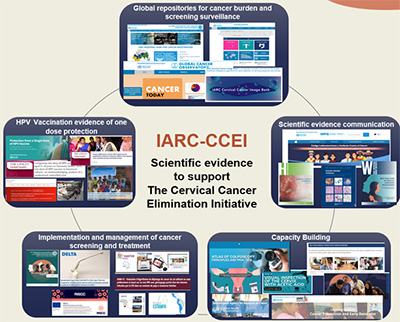Starting date: April 2023
Work Programme
The International Agency for Research on Cancer (IARC) and the World Health Organization (WHO) have complementary functions and mandates to advance cancer control globally. In November 2020, WHO formally launched the Global Strategy to Accelerate the Elimination of Cervical Cancer. IARC is supporting this WHO initiative by providing key evidence, technical materials, and updates for policy-makers, programme managers, and experts implementing the strategy.
The Cervical Cancer Elimination Initiative (CCEI) is supported by three key strategic pillars, with the following targets:
- Vaccination: 90% of girls fully vaccinated with the human papillomavirus (HPV) vaccine by the age of 15 years;
- Screening: 70% of women screened using a high-performance test by the age of 35 years, and again by the age of 45 years;
- Treatment: 90% of women with precancer treated and 90% of women with invasive cancer managed.
Countries should meet the 90–70–90 targets by 2030 to get on the path towards eliminating cervical cancer by the end of this century.
The IARC CCEI Team was formed with the purpose of enhancing communication and coordination with the WHO Cancer Team, as well as facilitating the exchange of knowledge and expertise related to the CCEI.
The primary aim of the IARC CCEI Team is to facilitate communication and coordination among the CCEI partners, including WHO, and to exchange scientific evidence, expertise, and updates about the ongoing relevant IARC initiatives and publications. IARC’s current initiatives and most recent publications to support the CCEI are listed below.
Team Composition
Team Leaders:
Dr Mary Luz Rol (Scientist) and Dr Partha Basu (Branch Head), Early Detection, Prevention, and Infections Branch (EPR), IARC
Emails: RolM@iarc.who.int; BasuP@iarc.who.int
Team members:
Dr Gabrielle Goldman-Lévy (Pathologist, ESC)
Dr Dilani Samarawickrema Lokuhetty (Deputy Branch Head, ESC)
Dr Freddie Bray (Branch Head, CSU)
Dr Ariana Znaor (Scientist, CSU)
Ms Anouk Berger (Branch Head, LCB)
Dr Tarik Gheit (Scientist, GEM)
Dr Tatiana Ramirez (Postdoctoral Scientist, EPR)
Mr Eric Lucas (Scientist, EPR)
Dr Iacopo Baussano (Scientist, EPR)
Key research
51 ongoing research and capacity-building projects to support the CCEI.
Website: https://screening.iarc.fr/cervical_cancer.php
11 projects on HPV vaccination:- 9 research projects
- 1 training course
- 1 global surveillance project
28 projects on cervical cancer screening:
- 21 research projects
- 1 communication report
- 5 training courses
- 1 global surveillance project
12 projects on cervical cancer treatment:
- 6 research projects
- 1 communication report
- 4 training courses
- 1 global surveillance project
Key publications
- Joshi S, Muwonge R, Bhosale R, Chaudhari P, Kulkarni V, Mandolkar M, et al. (2025). A randomised controlled non-inferiority trial to compare the efficacy of ‘HPV screen, triage and treat’ with ‘HPV screen and treat’ approach for cervical cancer prevention among women living with HIV. Nat Commun. 16(1):1888. https://doi.org/10.1038/s41467-025-56926-3 PMID:39987163
- Ramírez AT, Clifford GM, Dillner J, Kuhn L, Arbyn M, Bhatla N, et al. (2025). Reflections regarding validation of new HPV tests with reduced HPV genotypes: report from an IARC expert consultation. J Med Virol. 97(3):e70310. https://doi.org/10.1002/jmv.70310 PMID:40109087
- Basu P, Mwanahamuntu M, Pinder LF, Muwonge R, Lucas E, Nyambe N, et al. (2024). A portable thermal ablation device for cervical cancer prevention in a screen-and-treat setting: a randomized, noninferiority trial. Nat Med. 30(9):2596–604. https://doi.org/10.1038/s41591-024-03080-w PMID:38918630
- Mallafré-Larrosa M, Chandran A, Oswal K, Kataria I, Purushotham A, Sankaranarayanan R, et al.; ACCI Consortium (2024). Improving access to cancer care among rural populations in India: development of a validated tool for health system capacity assessment. Cancer Med. 13(14):e7343. https://doi.org/10.1002/cam4.7343 PMID:39039809
- Malvi SG, Esmy PO, Muwonge R, Joshi S, Poli URR, Lucas E, et al. (2024). A prospective cohort study comparing efficacy of 1 dose of quadrivalent human papillomavirus vaccine to 2 and 3 doses at an average follow up of 12 years postvaccination. J Natl Cancer Inst Monogr. 2024(67):317–28. https://doi.org/10.1093/jncimonographs/lgae042 PMID:39529521
- Man I, Georges D, Basu P, Baussano I (2024). Leveraging single-dose human papillomavirus vaccination dose-efficiency to attain cervical cancer elimination in resource-constrained settings. J Natl Cancer Inst Monogr. 2024(67):400–9. https://doi.org/10.1093/jncimonographs/lgae035 PMID:39529528
- Mosquera I, Barajas CB, Theriault H, Benitez Majano S, Zhang L, Maza M, et al. (2024). Assessment of barriers to cancer screening and interventions implemented to overcome these barriers in 27 Latin American and Caribbean countries. Int J Cancer. 155(4):719–30. https://doi.org/10.1002/ijc.34950 PMID:38648380
- Ramírez AT, Mesher D, Baena A, Salgado Y, Kasamatsu E, Cristaldo C, et al. (2024). Impact of knowledge of HPV positivity on cervical cytology performance in Latin America. J Natl Cancer Inst. djae283. https://doi.org/10.1093/jnci/djae283 PMID:39531343
- Singini MG, Muchengeti M, Sitas F, Chen WC, Combes JD, Waterboer T, et al. (2024). Antibodies against high-risk human papillomavirus proteins as markers for noncervical HPV-related cancers in a Black South African population, according to HIV status. Int J Cancer. 155(2):251–60. https://doi.org/10.1002/ijc.34919 PMID:38577820
- Wei F, Georges D, Man I, Baussano I, Clifford GM (2024). Causal attribution of human papillomavirus genotypes to invasive cervical cancer worldwide: a systematic analysis of the global literature. Lancet. 404(10451):435–44. https://doi.org/10.1016/S0140-6736(24)01097-3 PMID:39097395
Other relevant publications View PDF


